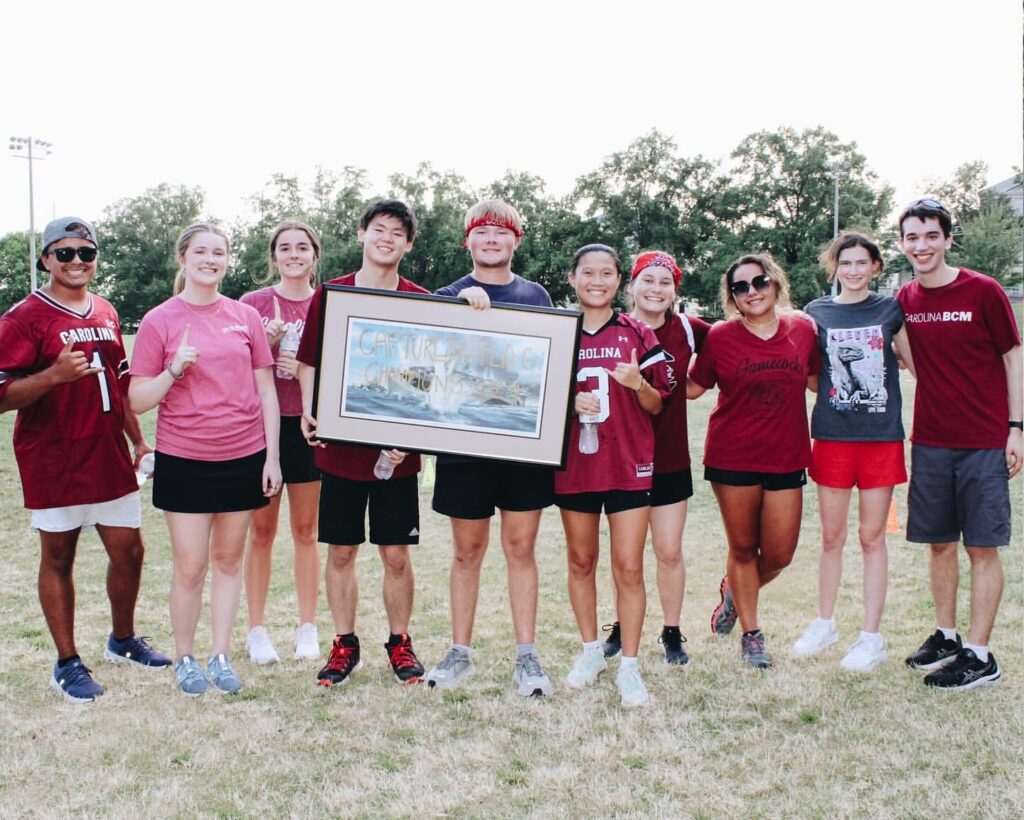“Tell me and I forget, teach me and I may remember, involve me and I learn.” – Benjamin Franklin
Leadership is more than authority. Leadership is about equipping others to thrive. In college ministry and beyond, effective leadership means helping people grow, not just telling them what to do.1 The TEAM Model offers a practical and biblical approach to developing leaders through a progressive process of training, support, and empowerment. Whether you are mentoring a new student or guiding someone into greater responsibility, the TEAM Model can help you lead with purpose and clarity.2
What is the TEAM Model?
The TEAM Model is a four-stage process built around the acronym TEAM—Teach, Equip, Assist, and Make them feel like a Champion. Each phase represents a different stage in a person’s leadership development, offering a clear path from initial learning to confident independence. Rooted in biblical principles of discipleship, the model emphasizes intentional mentoring, hands-on guidance, and gradual release of responsibility.3
Let’s explore each phase:
T – Teach: Demonstrate Direction (I Do / You Watch)
Key Phrase: “I teach by demonstrating direction, you watch and discern.”
Key Verse: “And the things you have heard me say in the presence of many witnesses entrust to reliable people who will also be qualified to teach others.”– 2 Timothy 2:2
In this foundational phase, the leader demonstrates what needs to be done while the learner watches and absorbs. The goal is to build understanding through observation and explanation.
Leader’s Role:
- Clearly model tasks and expectations
- Break down complex actions into simple steps
- Answer questions and address concerns
Follower’s Role:
- Observe attentively
- Ask clarifying questions
- Begin grasping the “why” and “how”
This stage is vital in establishing trust and setting a strong foundation for development.
E – Equip: Facilitate Function (I Do / You Help)
Key Phrase: “I enable by facilitating function, you help and find your footing.”
Key Verse: “To equip his people for works of service, so that the body of Christ may be built up.” – Ephesians 4:12
Now the follower begins to participate. The leader still leads, but the follower contributes. This is a hands-on stage where learners are given tools and guided practice.
Leader’s Role:
- Provide resources and tools
- Offer coaching and real-time feedback
- Create safe opportunities for practice
Follower’s Role:
- Try tasks with supervision
- Learn through doing
- Build confidence by asking for support when needed
This stage builds skill while minimizing risk and fear of failure.
A – Assist: Guide Growth (You Do / I Help)
Key Phrase: “You assist your task; I guide growth with guidance.”
Key Verse: “Carry each other’s burdens, and in this way you will fulfill the law of Christ.” – Galatians 6:2
The learner begins to take more ownership of their work while the leader supports from the sidelines. This is where real transformation begins, when leaders emerge as they are trusted to act with increasing independence.
Leader’s Role:
- Provide support as needed
- Encourage self-reflection and ownership
- Ask questions that prompt critical thinking
Follower’s Role:
- Complete tasks more independently
- Seek feedback for growth
- Develop problem-solving skills
This phase is marked by partnership, not oversight. You want to offer freedom with support.
M – Make Them a Champion: Witness Winning (You Do / I Watch)
Key Phrase: “You manage your work; I witness winning with warm welcome.”
Key Verse: “Have confidence in your leaders and submit to their authority, because they keep watch over you…so that their work will be a joy, not a burden.” – Hebrews 13:17
In the final stage, the follower operates independently, demonstrating mastery. The leader’s role is now one of encouragement, celebration, and ongoing availability. Success is shared and celebrated.
Leader’s Role:
- Monitor and affirm
- Celebrate milestones and successes
- Provide continued mentorship as needed
Follower’s Role:
- Lead confidently and independently
- Mentor others
- Continue growing and taking on new responsibilities
- This phase empowers the follower to step into leadership and repeat the cycle with others.
Why the TEAM Model Works
- Structured Development: Offers a clear roadmap for growth
- Empowerment: Builds confidence and ownership
- Effective Communication: Encourages clarity and regular feedback
- Stronger Teams: Cultivates capable, trusted leaders
- Encouraging Environment: Promotes morale and motivation
- Biblical Foundation: Reflects scriptural leadership and discipleship models
- Easy to Remember: The acronym and alliteration aid practical use
Tips for Using the TEAM Model
- Assess the Starting Point: Don’t rush. Start where the follower is, not where you want them to be.
- Stay Flexible: People grow at different rates.
- Celebrate Often: Don’t just correct mistakes. Celebrate progress.
- Use Prayer: Ask God to guide your leadership and your disciple’s journey.
- Be Patient: Growth takes time. Your consistency matters.
- Keep Communicating: Clear expectations and feedback make all the difference.
Practical Examples of TEAM in Action
Here’s how the TEAM model can play out in real-world college ministry discipleship scenarios:
1. Attending Worship & Choosing a Church Service
- Teach: Invite a student to your church; explain the value of gospel-centered worship.
- Equip: Visit several churches together and discuss key elements like doctrine and community.
- Assist: Encourage the student as they attend regularly and make their own choice.
- Make Them a Champion: Celebrate when they join, serve, and invite others.
2. Doing Daily Quiet Times
- Teach: Model your quiet time—Bible reading, journaling, and prayer.
- Equip: Provide a Bible plan, journal, or app; do it together a few times.
- Assist: Check in weekly as the student builds a rhythm.
- Make Them a Champion: They develop consistency and encourage others to do the same.
3. Being in an Accountability Group
- Teach: Explain the purpose; let the student observe a healthy group.
- Equip: Help them join and learn to ask good questions and share.
- Assist: Support them as they start leading check-ins.
- Make Them a Champion: They launch their own group and mentor others.
4. Making Smart School & Life Decisions
- Teach: Walk through biblical principles on time and priorities.
- Equip: Review schedules and goals together.
- Assist: Support them as they make decisions and grow in confidence.
- Make Them a Champion: They lead others in wise decision-making.
5. Sharing the Gospel
- Teach: Demonstrate gospel conversations in everyday settings.
- Equip: Role-play and assist as they share with a friend.
- Assist: Encourage and coach as they take initiative.
- Make Them a Champion: They share boldly and train others to do the same.
6. Going on a Mission Trip
- Teach: Share your past experiences and cast vision.
- Equip: Help them prepare, raise funds, and train with the team.
- Assist: Support them during the trip while mentoring.
- Make Them a Champion: They lead future trips or inspire others to go.
7. Being Mentored (Discipleship)
- Teach: Meet regularly, set goals, and explain the discipleship process. Go through Growing Up by Robby Gallaty. Buy the book for them.
- Equip: Help them share and grow spiritually. Go through chapters weekly for ten weeks.
- Assist: Let them drive the meetings with your support.
- Make Them a Champion: They seek mentoring and start mentoring others.
8. Investing in Someone Younger
- Teach: Let them observe you discipling another person.
- Equip: Co-lead or support their first discipling meetings. Have them buy a copy of Growing Up by Robby Gallaty book for their new disciple.
- Assist: Guide them as they disciple independently.
- Make Them a Champion: They mentor with confidence and multiply impact.
Conclusion
Leadership is not about control. It’s about development. The TEAM model gives a biblical, practical path for helping others grow from curious beginners to confident leaders. By starting with teaching, moving through equipping and assisting, and ending with empowerment, you create a lasting impact in people’s lives and in the kingdom of God. Whether in church, campus ministry, or everyday relationships, the TEAM model will help you lead with wisdom, purpose, and joy.
Adam Venters is the Director of Carolina BCM in South Carolina. You can learn more about the ministry at carolinabcm.org.
- This model is adapted from “The Leadership Square” of Mike Breen. See Mike Breen, “Building a Discipling Culture” (3dm International, 2014). ↩︎
- Jay Hidalgo, “The Leadership Square: A Framework for Developing Leaders,” The Barzel Group, June 12, 2019, https://barzelgroup.com/a-simple-framework-for-leadership-development/. Secular leadership has adapted this model into the TELL, SHOW, DO, and REVIEW. ↩︎
- Irving and Strauss use the leadership square model to focus on empowering students. They say, “A commitment to developing followers requires leaders to both equip and empower. When one is present without the other, this inevitably leads to problems for the follower, leader, and organization alike. When I (Justin) teach on this theme, I share the following equations: with students: empowerment—equipping = follower failure; equipping—empowerment = follower frustration; equipping + empowerment = follower flourishing.” Justin A. Irving and Mark L. Strauss, Leadership in Christian Perspective: Biblical Foundations and Contemporary Practices for Servant Leaders (Grand Rapids, MI: Baker Academic, 2019), 25. ↩︎






